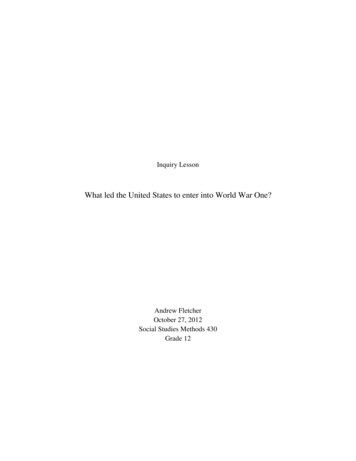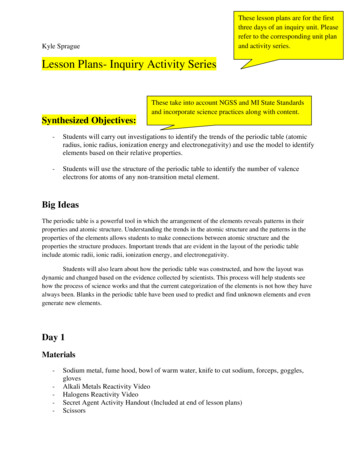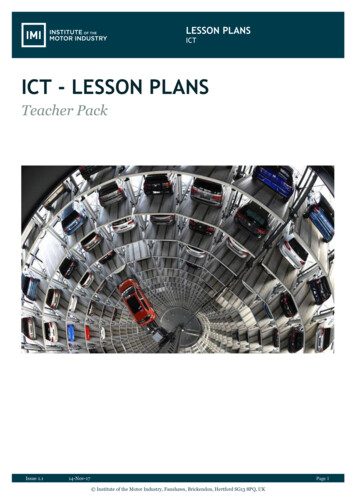
Transcription
Inquiry LessonWhat led the United States to enter into World War One?Andrew FletcherOctober 27, 2012Social Studies Methods 430Grade 12
Inquiry Lesson: What led the United States to enter into World War One?OVERVIEWOn July 28, 1914 the First World War began with the declaration of war on Serbia by the AustroHungarian Empire. In short order, the European alliance system compelled the continent’s nations to jointhe fray, and on August 4, with Britain’s declaration of war on Germany, all the Great Powers of the worldwere involved in what would become the deadliest conflict in human history to that point – all but one thatis. Also on August 4, United States President Woodrow Wilson addressed Congress with a declaration ofneutrality, a position favored by the majority of the American population. His address recognized thecultural connection the people of the nation had to both sides in the conflict, and he warned againstpartisanship, that “every man who really loves America will act and speak in the true spirit of neutrality.”Yet the United States would not be able to maintain its neutrality. After two and a half years of pressuresto join the war, Wilson sought a declaration of war from Congress which was granted April 6, 1917.Historians still debate the primary reason behind the president’s decision. Thus, students will reviewprimary and secondary documents that cover many of the perceived motives for the declaration of war inorder to form a conclusion to the central question: What led the United States to enter into World WarOne?RATIONALEThe decision to go to war ranks among the most serious actions a nation can undertake. Students need tounderstand the potential pull that honor, pride, economics, morality, carelessness, and a host of otherfactors may contribute to a nation’s desire engage in such a destructive event. The United States inparticular faces this dilemma generation after generation, and by reviewing our past decisions to go to warour students will be better equipped to make informed and reasoned decisions to avoid or engage in war inthe future. World War One is remarkably relevant in pursuing this wisdom. National pride, economicsecurity, and moral righteousness are at the forefront of thought for the nation’s entrance into the conflict.Are these sufficient justifications for the loss of 120,000 Americans or the contribution to a war thatdevastated the world and resulted in deaths of millions of lives?AUDIENCE and TIMEThis inquiry lesson is most appropriate for 12th grade students in an advanced placement U.S. history,world history, or European history course. Many of the documents presented are long, complex, and willrequire proficient reading skills to complete in the assigned timeframe. However, with minimalreductions or replacements of the data sets, this lesson could be used any highschool grade. Priorknowledge of World War One is not essential; however, initial hypotheses will be better attained if thestudents do have some background of the conflict. Introducing this inquiry lesson after discussing thewar’s origin and the conflict itself up to the point of U.S. entry should be sufficient. This lesson is wellsuited for placement chronologically in courses or thematically as America’s emergence onto the worldstage. The recommended time allocated for this lesson is five or six 60 minute class periods. Thisestimate is due to the number and size of documents involved in the inquiry process, extensive use ofgroup and class discussion, and an out-of-class assessment that may require a weekend to complete.
OBJECTIVESBy engaging in this inquiry lesson students will:o Study potential motives for the United States’s entry into the First World War and identify suchmotives during discussions and through written assignments;o Analyze and evaluate primary and secondary sources with conflicting evidence and perspectivesand describe such differences during discussions and through written assignments;o Asses the credibility of such sources during discussions and through written assignments;o Make a reasoned hypotheses for what caused the U.S. to join the war using evidence duringdiscussions;o Create a tentative conclusion to the central question and defend that position logically withevidence during discussions and through written assignments;o Engage in thoughtful discussions in which evidence is used to support their positions;o Respectfully consider and react to differing opinions, and potentially alter their own position basedon the views of others expressed during discussions;o Gain an appreciation and show empathy for the sacrifices made for the war, and internally debatethe values of life, honor, freedom, and duty while constructing their final conclusion; ando Learn the basic roles of the United States during the First World War through evidence presentedin data sets and during discussions, including: a general attitude to avoid participation in the war, arelative late entrance into the conflict, a significant industrial and agricultural supplier to theAllies, and a relatively smaller role in military actions than most of the other European states.WISCONSIN MODEL ACADEMIC STANDARDS ADDRESSED IN THE INQUIRYB.12.1. Explain different points of view on the same subject using data gathered from various sources,such as letters, journals, diaries, newspapers, government documents and speeches.o This is a requirement of the persuasive essay assignment using data set evidence.B.12.2 Analyze primary and secondary sources related to a historical question to evaluate theirrelevance, make comparisons, integrate new information with prior knowledge, and come to areasoned conclusion.o This will occur using the data set evidence during discussions and finalized in the essay.B.12.4 Assess the validity of different interpretations of significant historical events.o This will occur during class discussions and in the persuasive essay.B.12.11 Compare examples and analyze why governments of various countries have sometimes soughtpeaceful resolution to conflicts and sometimes gone to war.o Determining why the U.S. entered WWI is the entire premise of this inquiry.B.12.15 Identify a historical or contemporary event in which a person was forced to take an ethicalposition, such as a decision to go to war, the impeachment of a president, or a presidentialpardon, and explain the issues involved.o Data set 11 outlines President Wilson’s reasoning for going to war.D.12.13 Describe and explain global economic interdependence and competition using examples toillustrate their influence on national and international policies.o Data sets 4 and 5 and the disconfirming data set provide information and evidence thatsuggests the Allies’ dependence on foreign imports was contributing factor to the UnitedStates’ entrance into the war, and teacher input during discussion will add to this topic.
MATERIALSThe materials necessary to complete this inquiry lesson include:o Copies of the Hypothesis/Evidence Tracking Sheet for each studento Copies of Prelude to War introduction sheeto Copies of the data sets for each studento Copies of the Document Analysis Sheet for each student (optional- one for each group)o Copies of the Persuasive Essay Assignment for each studento A computer with internet accesso Internet sites: PBS American Experience: Woodrow Wilson Part Two; The Redemption of the World foundat: http://www.youtube.com/watch?v RQXBGLrtqx8. PBS: Gallery; Poster Art of World War 1 found at:http://www.pbs.org/wgbh/amex/wilson/gallery/p war 03.html. Opening scene of 1979 version of All Quiet on the Western Front found at:http://www.youtube.com/watch?v SXtsiqrhqsU.o Video projector/Smart Boardo DVD player and television (If computer and internet access is not available)o Overhead projector or document camerao Transparencies (if overhead projector is used)o Chalkboard/Whiteboard with appropriate writing utensilsINQUIRY LESSON PROCEDURE1. ENGAGEMENT IN THE INQUIRYTo gain students’ interest in the inquiry as well as show the seriousness of the topic at hand, show a clipwhich depicts a conflict role that the United States was typically involved in during the war: Atlanticwarfare, airborne warfare, or trench warfare. There are many primary source clips available on theinternet for use. However, one recommendation that is higher quality and likelier to gain interest is theopening scene (4 minutes) of the 1979 version of All Quiet on the Western Front available at:http://www.youtube.com/watch?v SXtsiqrhqsU. Although the scene does not portray Americans, it istypical of what American troops encountered on the western front. The scene shows the futility of trenchwarfare as an Allied assault against a German position fails, followed by a failed German counterattack.After watching the opening scene from All Quiet on the Western Front, load part two of the PBSdocumentary American Experience: Woodrow Wilson found athttp://www.youtube.com/watch?v RQXBGLrtqx8, or use DVD if internet is not available. Only thescenes from the following time segments are necessary: 9:10-14:30 and 24:00-26:10.The purpose of the two sets of videos is to gain the attention and interest of the students as well as providea limited yet adequate background on potential reasons for U.S. entrance into the war. The first clip is anattention grabber with its action portraying a seemingly futile effort of war. The Woodrow Wilson clipsportray the president’s personal desire to remain neutral in the war because of his childhood experience inthe post-Civil War South and the potentially divided loyalties of the large immigrant population of thenation. Furthermore, the topics of submarine warfare, economic ties to Europe, and democratic
civilization are mentioned as possible reasons for U.S. entry into the war: these are the strongest answersto the inquiry’s central question, and they are the most focused issues in the documents provided in theinquiry’s data sets.Finally, distribute a copy of the Prelude to War sheet to each student. Have a student that is particularlyvocal and animated in his/her reading read the Prelude to War to the class. This sheet gives additionalbackground to World War One as well as significant reasons for discussing the topic today. The intent ofthis sheet is to instill a sense of purpose in the inquiry lesson; that the inquiry into U.S. entrance into thewar is a relevant topic.2. ELICIT HYPOTHESESAfter completing the engagement, write the following question on the board: What led the United States toenter World War One? The central question should be displayed at all times during each day of thelesson. Distribute copies of the Hypothesis/Evidence Tracking Sheet to each student and have themindividually create and record hypotheses that might answer the question in the appropriate column of theworksheet. After the students have created a few hypotheses, explain the general purpose and process ofan inquiry lesson. The students should know that they will be presented with data sets which includeinformation which might support, undermine, or add new hypotheses to the Hypothesis/Evidence TrackingSheet. The students should understand that they are expected to keep accurate records of what data setssupport or undermine their hypotheses and for what reasons they do so because the information from thedata sets and Hypothesis/Evidence Tracking Sheet will be used for creating a written assignment at the endof the inquiry lesson. Inform them that participation in group and class discussion of the data sets isessential to developing in-depth understanding of the material presented, and that greater participation willaid them in the creation of their final written assignment and contribute to their informal assessment.Following the explanation of the inquiry lesson, divide the class into groups of 4-5 students. Have themshare their individual hypotheses amongst the group and create new hypotheses in the process. Have onestudent from each group present one of the group’s hypotheses to the class, and continue this process withdifferent members of each group until all prospective hypotheses created in the class have been described.The teacher should not suggest correctness or incorrectness of any of the students’ hypotheses. Duringthis process each student should add any new hypotheses to their own Hypothesis/Evidence TrackingSheet. Additionally, either the teacher or one student should record one “master list” for the class on anoverhead transparency, a Smartboard projection, or some other means which can be saved and presentedfor the class during each day of the inquiry lesson. An optional procedure the teacher may choose to takewould be to have students develop a few unlikely or “out-of-the-box” hypotheses that may create an addedcuriosity for the students as well as further develop their ability to disregard unsupportable hypotheses.3. DATA SET ANALYSIS and HYPOTHESES EVALUATIONPresentation of the data sets is the most significant aspect of the inquiry lesson plan. Prior to delivery ofthe data sets, give each student one copy of the Document Analysis Sheet, so the students know how theyshould attempt to interpret the data sets. The teacher has some discretion as to the manner in which thedata sets are delivered, dependant on time and the degree to which the students can analyze the setswithout teacher guidance. Ideally, each data set should be presented individually, and time allowed for thestudents to review and analyze them both individually and in groups prior to a class wide discussion ofeach set –the first few data sets may be read aloud and done as a class if the teacher feels it appropriate to
give the students practice. If time is at a premium or the students are experienced at reviewing suchdocuments, the teacher may opt to deliver the data sets in pairs or threes after the first few sets have beendiscussed. Regardless of the delivery method, each data set should be thoroughly discussed as a class. Ifan overhead projector or document camera is available, the data sets can be displayed for the class.During class discussion, the teacher should attempt to elicit responses from each student at least once toensure they are grasping the inquiry process. The teacher should also use a Document Analysis Sheetduring class discussion and be sure that each of the main points on the Document Analysis Sheet isaddressed before delivering the next data set. It is expected that class discussion will be longer andteacher involvement will be greater during the earlier data set discussions, but as the students growaccustomed to the inquiry process, teacher involvement will lessen to the point of facilitator. The teachershould, however, encourage the students to defend any point of view on data sets with evidence foundwithin the documents. During discussion of the data sets students should mark their ownHypothesis/Evidence Tracking Sheet with data sets that support or undermine any hypotheses. Also, thestudents should make any relevant notes that might describe why the data sets support or underminespecific hypotheses. Any new hypotheses that arise after reading data sets should be added. The masterlist for the class should also be updated similarly by the teacher or a student during class discussions.Periodically, after a few data sets have been discussed, the teacher should ask for volunteers to give theiropinions on what hypothesis they are currently leaning toward being the correct conclusion to the centralquestion – natural locations for this question occur after data sets 3, 5, 10, and 12 (the final data set). Thisaspect of the inquiry lesson is critical for students to learn how to use evidence to support theirconclusions and to promote respect for opposing points of view since it is likely that not all students willbe of the same opinion in developing their conclusions. Some students may even be persuaded to altertheir own conclusion.In addition to the general guidelines described in the Document Analysis Sheet, there are specific aspectsto most data sets that the teacher should be sure is addressed by the students prior to moving on to the nextdata set. Those aspects are listed here:Data Set 1: Polling newspaper editors was a common manner to gain an impression of public opinionduring this time. Although editors do not speak directly for the people, they do have aconsiderable ability to influence public opinion.Data Set 2: The Bryce Report was a major issue in swaying public opinion. The Germans were generallydisdained for the very fact they invaded neutral Belgium.Data Set 3: The photo copy of this cartoon may not depict its complete meaning. Below the brute readsthe word “America,” implying Germany had the potential to attack America. There areseveral propaganda cartoons available online if a Smartboard or other projector is available.See http://www.pbs.org/wgbh/amex/wilson/gallery/p war 03.html for additional sources.Data Set 4: Students should understand that increased trade relations with nations typically indicate anincreased affection for those nations. Furthermore, nations which increase their importsdramatically tend to pay for such items on credit.Data Set 5: John Milton Cooper, Jr. is well respected historian regarding World War I.Data Set 6: The purpose of this graph is of secondary value to the inquiry. It should dispel any notionthe students have that the United States was the cause of Allied victory. This would be anappropriate time to indicate that Russia had withdrawn from the war at the same time the
Data Set 7:Data Set 8:Data Set 11:Data Set 12:U.S. entered. Any hypotheses indicating glory for the U.S. should be undermined due to thedeath tolls of the nations already at war.This issue of the New York Times had several articles regarding the sinking of the Lusitania.The tone of this article can be described as moderate in comparison to the others.Given the outrage in the nation over the sinking of the Lusitania, Wilson’s tone does notindicate a desire for war.Wilson’s request for a declaration of war is quite revealing. If time is available for the entiredocument, see ion.htm.Note that only the autocracies of Europe had territorial losses, even Russia though it was atonce an Ally. Explain that the Ottoman Empire was divided significantly in the Middle East.4. CONCLUSIONAfter all data sets have been distributed, evaluated, and discussed, debrief the class by asking for theirpositions on the strongest hypotheses remaining and what new information regarding America’s entranceinto the war they learned. Next, assign copies of the Persuasive Essay Assignment to each student ashomework. Good essays require time, and this assignment should be given several days, preferably aweekend, to complete. The Persuasive Essay Assignment is described in detail, but the students should bereminded that a convincing argument often requires recognition of the merits opposing views may have.When describing opposing views the students should give credence to these views and not attempt tomislead or misinterpret such views.When assignments have been completed and turned in, distribute copies of the Disconfirming Data Set toeach student (they no longer need to be in groups). This data set involves the Nye Committee reportstarted in 1934 and ended in 1936. The report had mixed reviews, but it generally suggested that the U.S.entered the war to protect Britain and France from defaulting on loans made by American banks, so thatthey could purchase American weapons and foodstuffs. This data set would support data sets 4 and 5, butcast doubt on conclusions regarding submarine warfare and democratic righteousness.Debrief students by getting their responses to the Disconfirming Data Set just as was done with theoriginal data sets. Ask for opinions on whether this data supported or undermined anyone’s conclusion.For those whom had their conclusion undermined, would this data have changed their opinion? With theremaining class-time, which should be considerable, end with a class discussion on the merits of the U.S.entering the war; should the U.S. have entered into WWI? Just as with all discussions in the class, thestudents should be encouraged to defend their positions; however, they may use their own opinions,judgments, and values to support their positions in addition to evidence created by the data sets.ASSESSMENTStudents will be assessed formally and informally. Informal assessment consists of students’ participationin group and class discussion of the data sets. The overall degree to which students defended theirpositions based on logic and evidence is a considerable aspect to the informal assessment, for it aids allstudents in developing their conclusions for the persuasive essay. The teacher must record such informalactivities throughout the course of the inquiry lesson. Formal assessment will be made with the gradingrubric for the persuasive essay.
MODIFICATIONS FOR INCLUSION OF STUDENTS WITH SPECIAL NEEDSGiven the frequency of reading and writing required during the inquiry lesson, students for whom Englishis a second language and students who otherwise encounter difficulties with reading and writing mayrequire special modification for their circumstance. All final modifications are, of course, at the discretionof the teacher and others responsible for such individuals’ education. Some suggestions are: the teachermay make copies of the class “master list” Hypothesis/Evidence Tracking Sheet for these students at theend of the final data set, so that such students can focus on discussions; groups may read the documentsorally and students with reading difficulty exempted from reading or given shorter documents; thepersuasive essay assignment may be modified to suit the student’s situation.
NameHypothesis/Evidence Tracking SheetHypothesisSupporting/Undermining Data Sets and Notes
Document Analysis SheetKeep these questions and suggestions in mind while reviewing the documents forthe inquiry lesson:Does this document support or undermine any of my conclusions? Does this document suggestany new conclusion I have not yet considered?When was this document made? Was it made before or after the event this inquiry is examining?Is this document a primary source or a secondary source?If it is a primary source, how relevant is the author/creator to the event this inquiry is examining?Does this author/creator have any potential bias?If it is a secondary source, how credible is the author/creator? Is the author/creator professional,experienced, or biased?Does the document create more questions? Are there aspects of the document that seemimportant, but you don’t know the meaning? If so ask another group member, then the teacher ifneeded.Documents are not an all-or-nothing source. If you gave a negative response to several of theabove questions it may be considered a weak piece of evidence. Generally, primary sourcedocuments are stronger than secondary sources, but if a primary source is rife with bias, asecondary source may be stronger. Be sure to weigh such questions when forming yourconclusion; don’t simply view the hypothesis with the most supporting documents as the winner.Remember, a document may support and undermine the same hypothesis depending on yourinterpretation of the document.
Prelude to WarIn the years following the Civil War, the United States enjoyed the fastesteconomic and industrial growth in the history of the world. By 1910, America hadbecome the world’s leading financial and industrial power, and she had taken herseat alongside Britain, France, Germany, Russia, and Austria-Hungary at the tableof Great Powers. Despite her prominent role in international politics, however, theUnited States was a comparatively weak military power with approximately100,000 active-duty military personnel.On July 28, 1914 the First World War began with the declaration of war onSerbia by the Austro-Hungarian Empire. In short order, the European alliancesystem compelled the continent’s nations to join the fray, and on August 4, withBritain’s declaration of war on Germany, all the Great Powers of the world wereinvolved in what would become the deadliest conflict in human history to thatpoint – all but one that is. Also on August 4, United States President WoodrowWilson addressed Congress with a declaration of neutrality, a position favored bythe majority of the American population. His address recognized the culturalconnection the people of the nation had to both sides in the conflict, and he warnedagainst partisanship. He noted that “every man who really loves America will actand speak in the true spirit of neutrality.” Yet the United States would not be ableto maintain its neutrality. After two and a half years of pressures to join the war,Wilson sought a declaration of war from Congress which was granted April 6,1917. The U.S joined the fight on the Allied side and ultimately mobilized 4.3million military personnel before the war’s end.Worldwide, more than 65 million military personnel were mobilized for theFirst World War, and 8.5 million combatants and 2 million civilians lost their lives.The war triggered a worldwide influenza pandemic that caused the deaths ofanother 6 million people, was a major factor in the cause of the Great Depression,gave rise to Adolph Hitler and the start of World War Two, and redrew the worldmap resulting in future conflicts in the southeast Europe, southeast Asia, and theMiddle East. The United States was involved in each of these terrible outcomesrelated to the Great War, and will likely continue to feel the effects for years tocome.Historians still debate the primary reason for U.S. entry into World WarOne. How is it that a nation so dedicated to neutrality could be drawn into such aterrible conflict so far from home? During this inquiry lesson you will be givenhistorical evidence and the perspectives of World War One historians that supportand undermine potential conclusions to the central question:What Led the United States to enter into World War One?
Data Set 1American Sympathies in the WarDo a majority of the American press or the American people favor the Germans or the Allies? Toapproach an answer to this question we have obtained statements from between 350 and 400editors, telling their own attitudes and the feelings of their communities toward the warringnations. We need hardly say that we give the result of this inquiry entirely without partizanship,and purely for our readers' information. The replies cover the country from the Atlantic to thePacific and from Mexico to the Canadian border.ATTITUDE OF THE PRESSOf the 367 replies, 105 editors report that they favor the Allies, 20 favor the Germans, and 242are neutral. Of the pro-Ally editors 34 are in the Eastern States, 13 in the Central, 47 in theSouthern, and 11 in the Western. Only one pro-German editor hails from the Eastern States,while 10 are from the Central, 5 from the Southern, and 4 from the Western group. The neutraleditors number 43 in the Eastern States, 112 in the Central, 51 in the Southern and 36 in theWestern.Extract From:“American Sympathies in the War,” The Literary Digest, 49 (14 November 1914): 939-41, 974-78.
Data Set 2Bryce Report into German Atrocities in Belgium, May 12, 1915The British government, headed by Prime Minister Herbert Asquith, concerned by persistentreports of German brutality towards the civilian population in invaded Belgium in 1914,consequently requested James Bryce to prepare an independent report based upon his and anappointed committee's findings.The committee might reasonably have been expected to present decidedly biased findings givenits entirely British composition. However Bryce was a widely respected former Ambassador tothe United States and his report was viewed as credible in Washington, thus seriously damagingGermany in the eyes of U.S. public and political opinion.The Bryce Report is a lengthy document. This is one excerpt:“Individual acts of brutality treatment of civilians, rape, plunder, and the like - were verywidely committed. These are more numerous and more shocking than would be expected inwarfare between civilised Powers, but they differ rather in extent than in kind from what hashappened in previous though not recent wars.“In all wars many shocking and outrageous acts must be expected, for in every large armythere must be a proportion of men of criminal instincts whose worst passions are unloosedby the immunity which the conditions of warfare afford.“Drunkenness, moreover, may turn even a soldier who has no criminal habits into a brute,who may commit outrages at which he would himself be shocked in his sober moments, andthere is evidence that intoxication was extremely prevalent among the German army, bothin Belgium and in France, for plenty of wine was to be found in the villages and countryhouses which were pillaged. Many of the worst outrages appear to have been perpetrated bymen under the influence of drink. Unfortunately little seems to have been done to repressthis source of danger.“In the present war, however - and this is the gravest charge against the German army the evidence shows that the killing of non-combatants was carried out to an extent forwhich no previous war between nations claiming to be civilised (for such cases as theatrocities perpetrated by the Turks on the Bulgarian Christians in 1876, and on theArmenian Christians in 1895 and 1896, do not belong to that category) furnishes anyprecedent.”firstworldwar.com, “Bryce Report into German Atrocities in Belgium, 12 May 1915,” available htm#(c) Accessed October 21, 2012.
Data Set 3Destroy This Mad BruteWhile England and France were depicted as “civilization,” Germany was shown as a “madbrute” — here, a giant, drooling gorilla wielding the
knowledge of World War One is not essential; however, initial hypotheses will be better attained if the students do have some background of the conflict. Introducing this inquiry lesson after discussing the war's origin and the conflict itself up to the point of U.S. entry should be sufficient. This lesson is well










